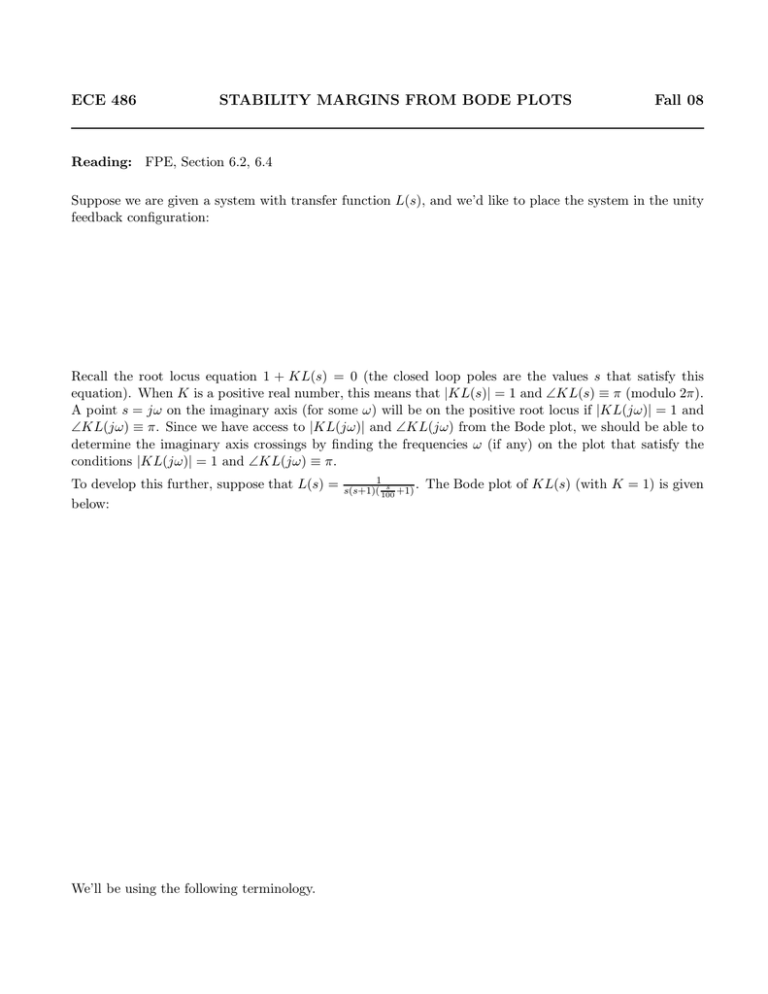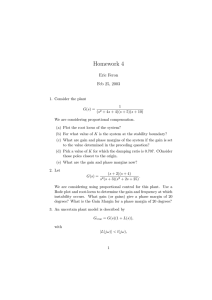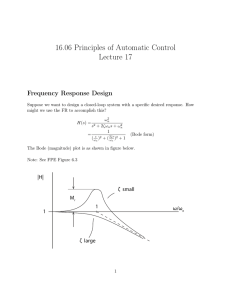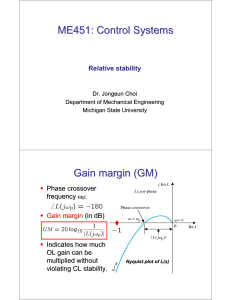ECE 486 STABILITY MARGINS FROM BODE PLOTS Fall 08
advertisement

ECE 486 STABILITY MARGINS FROM BODE PLOTS Fall 08 Reading: FPE, Section 6.2, 6.4 Suppose we are given a system with transfer function L(s), and we’d like to place the system in the unity feedback configuration: Recall the root locus equation 1 + KL(s) = 0 (the closed loop poles are the values s that satisfy this equation). When K is a positive real number, this means that |KL(s)| = 1 and ∠KL(s) ≡ π (modulo 2π). A point s = jω on the imaginary axis (for some ω) will be on the positive root locus if |KL(jω)| = 1 and ∠KL(jω) ≡ π. Since we have access to |KL(jω)| and ∠KL(jω) from the Bode plot, we should be able to determine the imaginary axis crossings by finding the frequencies ω (if any) on the plot that satisfy the conditions |KL(jω)| = 1 and ∠KL(jω) ≡ π. To develop this further, suppose that L(s) = below: We’ll be using the following terminology. 1 s s(s+1)( 100 +1) . The Bode plot of KL(s) (with K = 1) is given • Gain crossover frequency: This is the frequency ωcg such that |KL(jωcg )| = 1 (or equivalently, log |KL(jωcg )| = 0). • Phase crossover frequency: This is the frequency ωcp such that ∠KL(jωcp ) ≡ π. For the above example, we have ωcg ≈ 1 and ωcp ≈ 10. The phase at ωcg is approximately − 3π 4 , and so the feedback configuration with K = 1 does not have any closed loop poles on the imaginary axis. Is there another value of K for which the closed loop system will have poles on the imaginary axis (and thus cross the boundary from stability to instability)? To determine this from the Bode plot, note that log |KL(jω)| = log K + log |L(jω)| and ∠KL(jω) = ∠L(jω) (for K > 0). Thus, K has no effect on the phase, and it affects the magnitude plot by shifting it up or down by log K. For example, when K = 10, the entire magnitude gets shifted up by log 10 = 1 unit (when the vertical axis denotes log |KL(s)|); this is shown on the above Bode plot by the dashed lines. Based on this plot, we see that changing K has the effect of changing the gain crossover frequency (but not the phase crossover frequency). In order to find the value of K that causes some closed loop poles to lie on the imaginary axis in the above example, we need to find out how to make the gain crossover frequency and the phase crossover frequency coincide. Examining the magnitude plot, we see that log |L(j10)| ≈ −2, and thus the magnitude curve needs to be shifted up by approximately 2 units in order to set ωcg = ωcp, which can be accomplished by setting log K ≈ 2, or K ≈ 100. Thus, we can conclude that the closed loop system will have an imaginary axis crossing when K ≈ 100. One can easily see from the Bode plot that this is the only positive value of K for which this will happen. We can verify this result by examining the positive root locus of L(s): As expected, the branches cross the imaginary axis only once (other than the trivial case where K = 0). To find the locations where the branches cross, we note that ⇔ ⇔ 1 + KL(s) = 0 1 =0 1+K s s(s + 1)( 100 + 1) s3 + 101s2 + 100s + 100K = 0 . 2 We use the Routh-Hurwitz test to determine the region of stability as 0 < K < 101. Thus, we have a potential imaginary axis crossing at K = 101. To find the points on the imaginary axis where this happens, we set s = jω and K = 101 and solve the equation (jω)3 + 101(jω)2 + 100(jω) + 100(101) = 0 ⇔ − jω 3 − 101ω 2 + 100ωj + 100(101) = 0 . Setting the imaginary and real parts to zero, we find that ω = 10. Thus, we have an imaginary axis crossing at s = ±10j when K = 101. Note that this agrees with the analysis from the Bode plot (the Bode plot actually told us K ≈ 100, since we approximated the Bode plot with straight lines). While we could determine imaginary axis crossings by looking at the Bode plot, we didn’t necessarily know which direction the branches were going – are we going from stability to instability, or instability to stability? We could determine this information by looking at the root locus, but we will later develop a completely frequency domain approach to characterizing the stability of the closed loop system. For now, we will assume that the closed loop system is stable with a given value of K, and investigate ways to design controllers using a frequency domain analysis in order to improve the stability of the closed loop system. Stability Margins We will define some terminology based on the discussion so far. Consider again the Bode plot of KL(s) with K = 1: Assuming that the closed loop system is stable, we can ask the question: How far from instability is the system? There are two metrics to evaluate this: 3 • Gain margin: This is the amount by which K can be multiplied before |KL(jωcp )| = 1 (i.e., the gain crossover frequency and phase crossover frequencies coincide). • Phase margin: This is the amount by which the phase at ωcg exceeds −π; more specifically, it is defined as P M = ∠L(jωcg ) + π . In general, we would like to have large gain and phase margins in order to improve the stability of the system. In the above example with K = 1, the gain margin is approximately 100, and the phase margin is approximately π4 . Let us consider some more examples, just to be clear on the concept of gain and phase margins. Example. What is the gain margin and phase margin for KL(s) = Solution. 4 1 s(s+1)2 ? Example. What is the gain margin and phase margin for KL(s) = Solution. s+1 s s2 ( 10 +1) ? In the above example, we noticed that the gain margin is ∞, since the phase only hits −π at ω = ∞. However, note that as we increase K, the gain crossover frequency starts moving to the right, and the phase margin decreases. If we examine the root locus for the system L(s) = s2 (s+1 , we see that we have s +1) 10 a set of poles that move vertically in the plane as K → ∞, and thus the damping ratio ζ for these poles decreases as K → ∞. This seems to indicate that there might be some relationship between the phase margin and the damping ratio ζ. We will now derive an explicit relationship between these two quantities. Consider the system L(s) = 2 ωn s(s+2ζωn ) , which is placed in the feedback configuration The closed loop transfer function is Try (s) = 2 ωn 2, s2 +2ζωn s+ωn 5 which is the standard second order system with damping ratio ζ. The phase plot of L(jω) is given by This shows that the gain margin is ∞ (and this is easily verified by looking at the root locus). Next, let’s examine the phase margin. By setting the magnitude of L(jω) equal to 1, one can verify that the Bode plot of L(s) has gain crossover frequency equal to qp ωcg = ωn 1 + 4ζ 4 − 2ζ 2 . Using the fact that P M = ∠L(jωcg ) + π, we obtain (after some algebra) 2ζ . P M = tan−1 qp 4 2 1 + 4ζ − 2ζ Notice that the phase margin is a function of ζ and not ωn . Interestingly, this seemingly complicated expression can be approximated fairly well by a straight line for small values of ζ: 6 For 0 ≤ ζ ≤ 0.7, the phase margin and damping ratio are related by P M ≈ 100ζ . While we derived the above expression for the standard second order system, we can also use it as a general rule of thumb for higher order systems. Specifically, as the phase margin decreases, the system becomes less stable, and might exhibit oscillatory behavior. We can use the above relationship to design control systems in the frequency domain in order to obtain certain time-domain characteristics (such as meeting overshoot specifications). Another useful rule-of-thumb that is generally adopted is as follows: In general, we have ωcg ≤ ωBW ≤ 2ωcg , and ωBW ≈ ωn , which leads to the approximation ωBW ≈ ωcg ≈ ωn . Note that our discussions here have assumed a typical Bode plot that has large magnitude at low frequencies, and low magnitude at high frequencies, with a single gain crossover frequency. We can deal with more complicated Bode plots by generalizing our discussions, but we’ll focus on these typical Bode plots for now. In order to obtain fast transient behavior, we typically want a large gain crossover frequency, but this would come at the cost of decreasing the phase margin. Furthermore, in order to obtain better steady state tracking, we would typically want to increase the gain K in order to boost the low frequency behavior, but this would again move the gain crossover frequency to the right and decrease the phase margin. Therefore, we must consider more complicated controllers (other than just a simple proportional controller K) in order to obtain a good phase margin, a good gain crossover frequency, and good steady state tracking. This will be the focus of the next part of the course. 7



